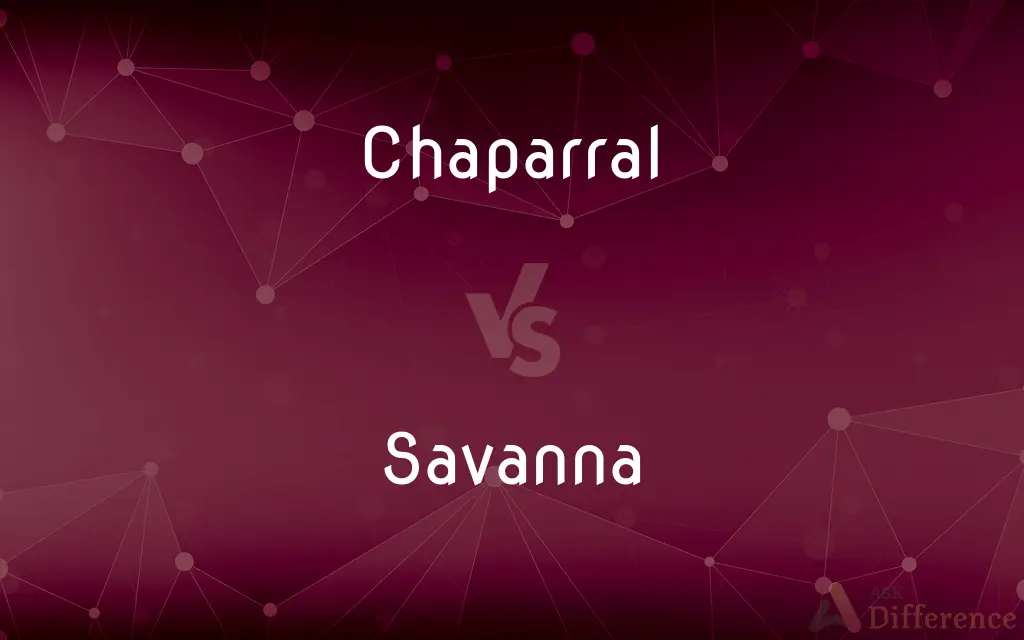Chaparral vs. Savanna — What's the Difference?
By Tayyaba Rehman — Updated on November 6, 2023
Chaparral is a shrubland or heathland plant community, while a savanna is a grassland ecosystem with scattered trees.

Difference Between Chaparral and Savanna
Table of Contents
ADVERTISEMENT
Key Differences
Chaparral is characterized by dense, woody shrubs and is found in regions with a Mediterranean climate. Savannas are known for their grassy plains with occasional trees and thrive in warm climates, often bordering deserts. Both ecosystems are adapted to their climates, but their vegetation density and types differ significantly.
The chaparral biome has a specific climatic pattern with wet winters and dry summers, promoting dense growth of tough, evergreen shrubs. Savannas, in contrast, experience a distinct seasonality with a wet season promoting grass growth and a dry season that can support wildfires, which maintain the ecosystem's open nature.
Fire plays a crucial role in both biomes but in different ways. In chaparral regions, infrequent but intense fires clear out old growth. Savannas experience more frequent fires that prevent tree dominance and encourage grassland continuity. The adaptation to fire is a common thread, but it shapes each biome distinctly.
The fauna in chaparral regions has adapted to a life hidden among thickets and rugged terrain, with species like coyotes and quails being common. In savanna landscapes, the open environment supports large herds of grazing animals such as zebras and gazelles, and the predators like lions that follow them.
While chaparral and savanna may share dry conditions, they exist on different continents and under different climatic conditions that dictate their unique biodiversity. The chaparral's dry summer and wet winter pattern is specific to the west coasts of continents, while savannas are often found closer to the equator, where seasonality is defined by rainfall rather than temperature.
ADVERTISEMENT
Comparison Chart
Climate
Mediterranean, with wet winters and dry summers.
Tropical or subtropical, with distinct wet and dry seasons.
Vegetation
Dense, woody shrubs and some drought-resistant trees.
Open grassland with scattered trees and shrubs.
Fire Regime
Less frequent, high-intensity fires.
More frequent, low-intensity fires.
Location
Typically found on the west coasts of continents.
Found near the equator, often between tropical rainforests and deserts.
Wildlife
Animals adapted to dense vegetation and rugged terrain.
Large herds of grazing animals and their predators.
Compare with Definitions
Chaparral
An ecosystem with a Mediterranean climate.
We studied the unique adaptations of chaparral plants to dry summers.
Savanna
An ecosystem with a wet-dry seasonal cycle.
The savanna turned green during the rainy season.
Chaparral
Dense vegetation comprising mainly of shrubs.
The chaparral covered the landscape, making the hike challenging.
Savanna
Home to diverse herbivores and their predators.
The lions of the savanna relied on the migration of wildebeest.
Chaparral
A biome found in coastal regions with dry summers.
Coastal California is known for its expansive chaparral regions.
Savanna
A grassy plain with scattered trees, typical in tropical regions.
Elephants roamed the vast savanna under the hot sun.
Chaparral
An almost impenetrable thicket or succession of thickets of thorny shrubs and brambles.
Savanna
Characterized by a mix of woodland and grassland.
Acacias dotted the savanna, providing shade and food for giraffes.
Chaparral
An area characterized by spiny shrubs and tough plants.
The chaparral was teeming with insect life despite its arid appearance.
Savanna
A savanna or savannah is a mixed woodland-grassland ecosystem characterised by the trees being sufficiently widely spaced so that the canopy does not close. The open canopy allows sufficient light to reach the ground to support an unbroken herbaceous layer consisting primarily of grasses.Savannas maintain an open canopy despite a high tree density.
Chaparral
Chaparral ( shap-ə-RAL, chap-) is a shrubland plant community found primarily in the U.S. state of California, in southern Oregon, and in the northern portion of the Baja California Peninsula in Mexico. It is shaped by a Mediterranean climate (mild wet winters and hot dry summers) and infrequent, high-intensity crown fires.
Savanna
A grassland with scattered tree growth, especially in a tropical or subtropical region.
Chaparral
An area covered by a dense growth of mostly small-leaved evergreen shrubs, especially in central and southern California.
Savanna
A tropical grassland with scattered trees
Chaparral
(US) A region of shrubs, typically dry in the summer and rainy in the winter. The coast of the Mediterranean is such a region.
Savanna
A tract of level land covered with the vegetable growth usually found in a damp soil and warm climate, - as grass or reeds, - but destitute of trees.
Savannahs are clear pieces of land without woods.
Chaparral
The foliage of creosote bush, Larrea divaricata, when used as a medicinal herb.
Savanna
A flat grassland in tropical or subtropical regions
Chaparral
A thicket of low evergreen oaks.
Savanna
Subject to regular fires that maintain its grassland state.
Fire swept across the savanna, a natural part of its renewal process.
Chaparral
Dense vegetation consisting of stunted trees or bushes
Chaparral
A plant community adapted to periodic wildfires.
After the fire, the chaparral began to regenerate rapidly.
Common Curiosities
What defines a chaparral?
Chaparral is defined by its dense, shrubby vegetation and Mediterranean climate.
What are some typical animals found in the savanna?
Typical savanna fauna includes zebras, elephants, and various antelope species.
Do savannas exist in North America?
North American savannas do exist but are less common than in Africa or South America.
Can chaparral be found outside of California?
Yes, chaparral biomes exist in other Mediterranean climates around the world.
Can chaparral regions be used for recreational activities?
Yes, but the rugged terrain and dense vegetation can limit access.
How do plants in the chaparral conserve water?
Chaparral plants often have small, leathery leaves to reduce water loss.
How do savanna ecosystems impact biodiversity?
Savannas support high biodiversity, particularly of grazing mammals and their predators.
Are there trees in the chaparral?
Yes, but they are less common and often dwarfed or twisted due to the harsh conditions.
Why are fires common in the savanna?
Savannas have frequent fires due to lightning and human activity, which help maintain the grassland ecosystem.
Is agriculture possible in the chaparral?
Agriculture in chaparral regions is challenging due to dry soils and water scarcity.
What role do humans play in chaparral and savanna environments?
Human activity affects both through urban development, agriculture, and influencing fire regimes.
Are chaparrals prone to drought?
Yes, chaparrals experience seasonal droughts, especially in the summer.
How does the wet season affect the savanna?
The wet season promotes lush grass growth, which supports a rich variety of herbivores.
Can chaparral and savanna biomes be found adjacent to each other?
No, they exist in very different climatic regions and are not typically adjacent.
What conservation efforts are in place for chaparrals and savannas?
Conservation efforts include fire management, protecting native species, and combating invasive plants.
Share Your Discovery

Previous Comparison
Chinese vs. Filipino
Next Comparison
Yonic vs. PhallicAuthor Spotlight
Written by
Tayyaba RehmanTayyaba Rehman is a distinguished writer, currently serving as a primary contributor to askdifference.com. As a researcher in semantics and etymology, Tayyaba's passion for the complexity of languages and their distinctions has found a perfect home on the platform. Tayyaba delves into the intricacies of language, distinguishing between commonly confused words and phrases, thereby providing clarity for readers worldwide.















































